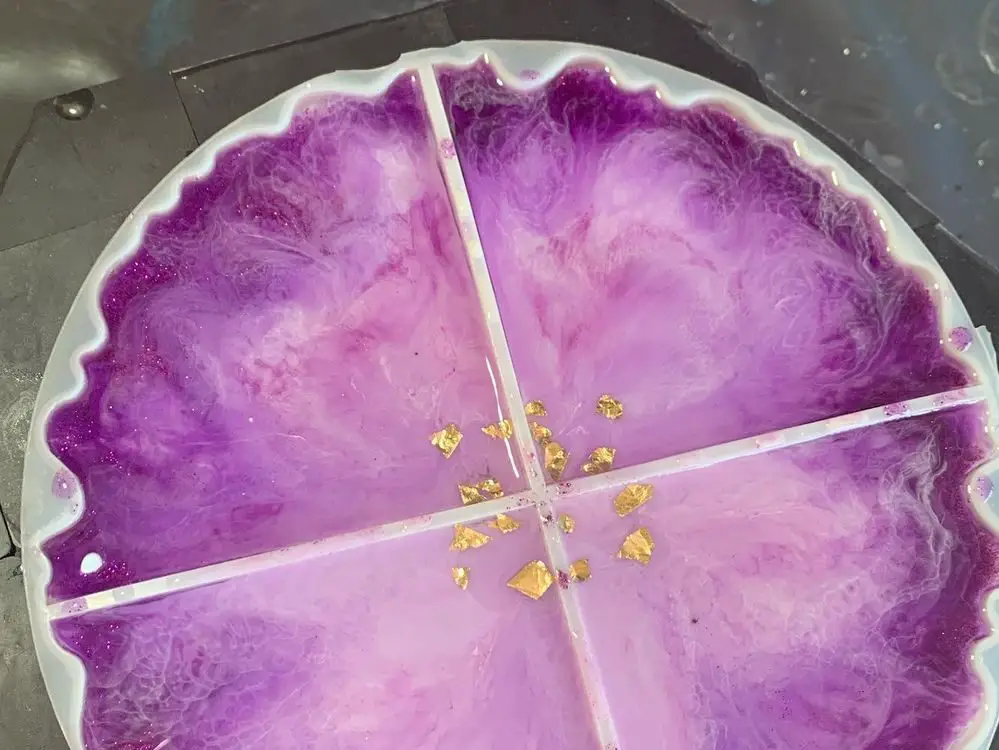Over the past few months spent in quarantine, students have found interesting and innovative ways to stay busy and make some extra cash. From candle making, acrylic pour painting and creating digital designs, artwork has been a therapeutic and financially promising field for many individuals. One unique hobby that grew in popularity over the last year is resin art. Working with resin can produce a variety of beautiful outcomes, like sparkly combs, handmade earrings or varnished countertops. With a pair of gloves, a bit of resin and some creativity, resin art can be your next hobby too. If you’re still unsure exactly what resin artwork entails, consider these questions before you start.
What is resin art?
Resin is a unique compound of chemicals that hardens to form a more durable material. Resin can solidify by adding a hardener or by exposing it to UV light, depending on the type of resin you choose. The synthetic substance can be used to create objects from molds or be added to a piece of artwork to protect it from wear.
There are four types of resin that are used to create art: epoxy, polyurethane, silicone and polyester “fiberglass” resin. Each one is best suited for a specific type of medium. To create jewelry and other objects using molds, epoxy resin is the best option and the easiest to use for beginners.
What is the history behind resin art?
Surprisingly, resin art has been around for centuries. Nature’s resin, otherwise known as amber, is produced by trees and fossilizes to create a hard, transparent slab. Amber has been used for hundreds of years as decorative ornaments or pieces of jewelry.
The more modern version of resin is made artificially and is used for similar purposes. Epoxy resin was first discovered in the 1930s. Once people realized it could be used to adhere items together or preserve objects, it was patented as its own product. Soon after, epoxy resin made its way into the art realm where it has been used ever since.
Why is resin art so popular?
While it has been around for more than half a century, the process of making these stunning creations has only recently arrived in the public eye. YouTube and TikTok are two influential video-sharing platforms that have allowed resin artists to showcase their art process. I was first exposed to the world of resin in early March when a viral TikTok about resin pouring appeared on my newsfeed. Since then, resin art has become an enjoyable hobby of mine that I turn to when I have some extra time on my hands.
Its debut on social media, coupled with individuals’ boredom during quarantine, has increased its popularity drastically. Not only are the finished results amazing and durable, but the process can be time-consuming, which is perfect for those stuck inside all day with nothing to do.
Along with its timeless functionality and simple aesthetic, resin art can appeal to even the most talentless individual, since it requires no drawing or painting abilities. According to thehindu.com, “[Resin’s] glass-like lustre and plastic-like composition is what makes resin both, attractive and versatile. It is as suitable for fluid art as it is for definitive structural pieces.” Simply put, resin is the chameleon of art supplies and can be used with a variety of mediums.
What can be made with resin?
There are virtually endless possibilities for what you can create with resin if you have a mold for it. If you’re looking to make your own accessories, pendants, combs and earrings are simple and fun to make. If you’re thinking about revamping your apartment, consider making your own resin coasters, ashtrays, cutting boards or serving trays. For those who would rather preserve items instead of using molds, table-top and canvas art both look striking with the glossy finish of resin. Creating your own resin art gives you expensive-looking decor at a fraction of the cost.
How can I make my own resin art?
The process starts with a few essential supplies: disposable cups, popsicle sticks, resin and hardener, molds and a measuring cup. Optional items that can be added to your pieces include dried flowers, resin dyes and glitter. To ensure your safety and to avoid damage to the table you’re working on, laying down newspaper and wearing gloves is recommended.
After you’ve prepared your workspace, measure a one-to-one ratio of resin and hardener into the disposable cup. Begin stirring slowly with the popsicle stick until any air bubbles are gone and the ingredients are fully combined. Before pouring the concoction into your mold, add your preferred dye color and gently mix. Add the resin carefully to the mold and leave it in a secured, open location to cure overnight. Once the resin is completely set — voilà! — you’ve created your own piece of resin art.
Where can I find resin products?
If making your own resin art seems too complex, buying resin products from artists on Etsy, Facebook Marketplace or local art fair booths is a great way to support small businesses and get envied pieces of art without making them yourself. While making resin art can be an entertaining way to kill time, waiting for the resin to cure or strategically placing each dried flower in the mold isn’t everyone’s cup of tea. Buying the resin artwork of others is still an admirable way to get a unique item while helping an up-and-coming artist.
Whether you’re looking for a time-consuming hobby or just want another skill under your belt, resin art is sure to be worth your while. Even if you’re not interested in making your own artwork with resin, you now have a better understanding of the process and a newfound respect for resin artists.
















